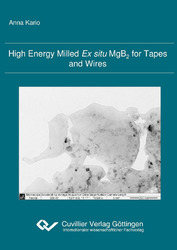| Departments | |
|---|---|
| Book Series (96) |
1378
|
| Nachhaltigkeit |
3
|
| Gesundheitswesen |
1
|
| Humanities |
2362
|
| Natural Sciences |
5406
|
| Engineering |
1790
|
| Engineering | 291 |
| Mechanical and process engineering | 861 |
| Electrical engineering | 686 |
| Mining and metallurgy | 30 |
| Architecture and civil engineering | 75 |
| Common |
97
|
|
Leitlinien Unfallchirurgie
5. Auflage bestellen |
|
Advanced Search
High Energy Milled Ex situ MgB2 for Tapes and Wires (English shop)
Anna Kario (Author)Preview
Table of Contents, Datei (36 KB)
Extract, Datei (530 KB)
1. The optimum solution for the difficulties during conductor deformation was to use the ex situ precursor powder which is not sensitive to heat treatments in the range of temperatures needed for the working stress release of the sheath metal. Two different ex situ powders are studied: homemade ex situ (based on mechanically alloyed in situ powder) and commercial powder with reduced crystallite size achieved by high energy ball milling.
2. As the first approach, ex situ powder is prepared using mechanical alloying. A detailed phase analysis shown secondary phases, such as MgO and MgB4+x. A high critical current density for unsintered tapes and wires was obtained. It is observed that non of the applied final heat treatments of the conductors improve their superconducting properties. It is assumed that, heat treatments influence the crystallite size which is explained by MgO at the grain boundaries blocking grain growth. Additional milling or chemical treatment of the powder to clean the grains is needed to accomplish a smaller particle size. However, if medium Jc values are sufficient, the MA in-ex situ powder is an interesting precursor powder for conductors needed for the react & wind method of superconducting coil preparation, because the final heat treatment of a such a conductor is not needed.
3. As the second approach, commercially available ex situ powder was milled to reduce grain size. The average crystallite size of the powder is reduced by ball milling drastically from 47 nm to 15 nm, however, this powder is highly reactive. Powders after 2 h or longer milling times exposed to air react rapidly with oxygen and create up to 40 wt% of secondary phases, like MgB4+x and MgO. This reaction can be avoided by using exclusively a protective atmosphere for the sample preparation.
Ex situ MgB2 stability examination via the decomposition behaviour.
4. The decomposition of MgB2 to Mg and higher borides at high annealing temperatures is observed in bulks and conductors. The temperature of the MgB2 decomposition decreases with increasing milling time. Unfortunately, the decomposition takes place at temperatures which are in the same range as the temperature needed for ex situ sintering. With increasing milling time, the crystallite size decreases and more powder is decomposed. It was found that an increased grain connection due to the milling and a decreased crystallite size play a larger role in increasing Jc than secondary phases. The milling process creates fresh reaction surfaces without a MgO layer for an improved grain connectivity.
5. The high reactivity of the powder caused by the high energy ball milling might be reduced by carbon addition. Carbon is successfully introduced into the lattice, as proved by a change in the lattice parameter, a decrease of Tc, an increase of the upper critical field and a change of the Jc dependence on applied field. The carbon substitution in the lattice is accomplished via high energy ball milling.
6. The best Jc results ( Jc=104 A/cm2 at 12.4 T) are obtained for the tape with the 20 h milled powder with 5 wt% of carbon addition. The precursor powder is well deformable: the
2 m long conductor was prepared using a combination of swaging, drawing and rolling with the help of intermediate heat treatments. Such additional heat treatments do not influence the precursor powder. Furthermore the carbon addition to the tape precursor increases the decomposition temperature of the powder, decreases its reactivity and improves the Jc(H) dependence of the tape in comparison to the tape with undoped precursor. The tapes prepared from that powder do not show a Jc anisotropy in respect to the field direction.
The ex situ powder was used as superconducting diffusion barrier for copper sheathed conductors to prevent reaction between filament and sheath.
7. In addition, ex situ powder is used as a chemical barrier in Glidcop®
in situ wires, substituting Nb or Ti which are commonly used. It is proved that the wire deformation by drawing with the powder barrier is possible. The effectiveness of the barrier in preventing a reaction between the Glidcop® sheath and the in situ MgB2 in wires heat treated both under ambient pressure and under high gas pressure was studied. It is found that this barrier is effective in preventing diffusion between Mg and Cu in the sheath only in the case of high pressure sintering. This novel technique allows to get relatively high values of the engineering critical current density Je (Je=104 A/cm2 at 5.3 T) because a high superconductor filling factor of 50% can be achieved. This is usually very challenging in powder-in-tube composite conductors with a diffusion barrier.
| ISBN-13 (Printausgabe) | 386955732X |
| ISBN-13 (Hard Copy) | 9783869557328 |
| ISBN-13 (eBook) | 9783736937321 |
| Final Book Format | A5 |
| Language | English |
| Page Number | 120 |
| Lamination of Cover | matt |
| Edition | 1 Aufl. |
| Volume | 0 |
| Publication Place | Göttingen |
| Place of Dissertation | TU Dresden |
| Publication Date | 2011-05-02 |
| General Categorization | Dissertation |
| Departments |
Mechanical and process engineering
Electrical engineering |
| Keywords | MgB2, Supraleitung, Bander, Bulk, Materialwissenschaften |








